Solar Panel Due to Continuous Recharging One Full Charge Can Run for 3 Days
There may not be a better pairing than home solar panels and electric cars. Both of these exciting technologies represent a major shift away from how things have been done for a long time, and together they are sparking a revolution in self-reliance, while also helping to lead to a better future for everyone.
First things first, choosing an electric car is just a smart thing to do. Even in the most expensive electricity markets, charging an EV is cheaper than buying gas for an internal combustion engine (ICE) car. Electric cars also have about 25% lower maintenance costs compared to ICE vehicles. Finally, EVs don't pollute the environment by burning fossil fuels.
Here's a quick example:
According to the U.S. Department of Transportation, the average American drives about 13,500 miles per year, or about 40 miles per day. Over the course of a year, the driver of a gas-powered Hyundai Kona will pay around $1,260 for the 450 gallons of gasoline they'd need to go that far (based on 30 mpg fuel economy). Gas prices fluctuate but they've been fairly steady for years now (except during the beginning of the pandemic):
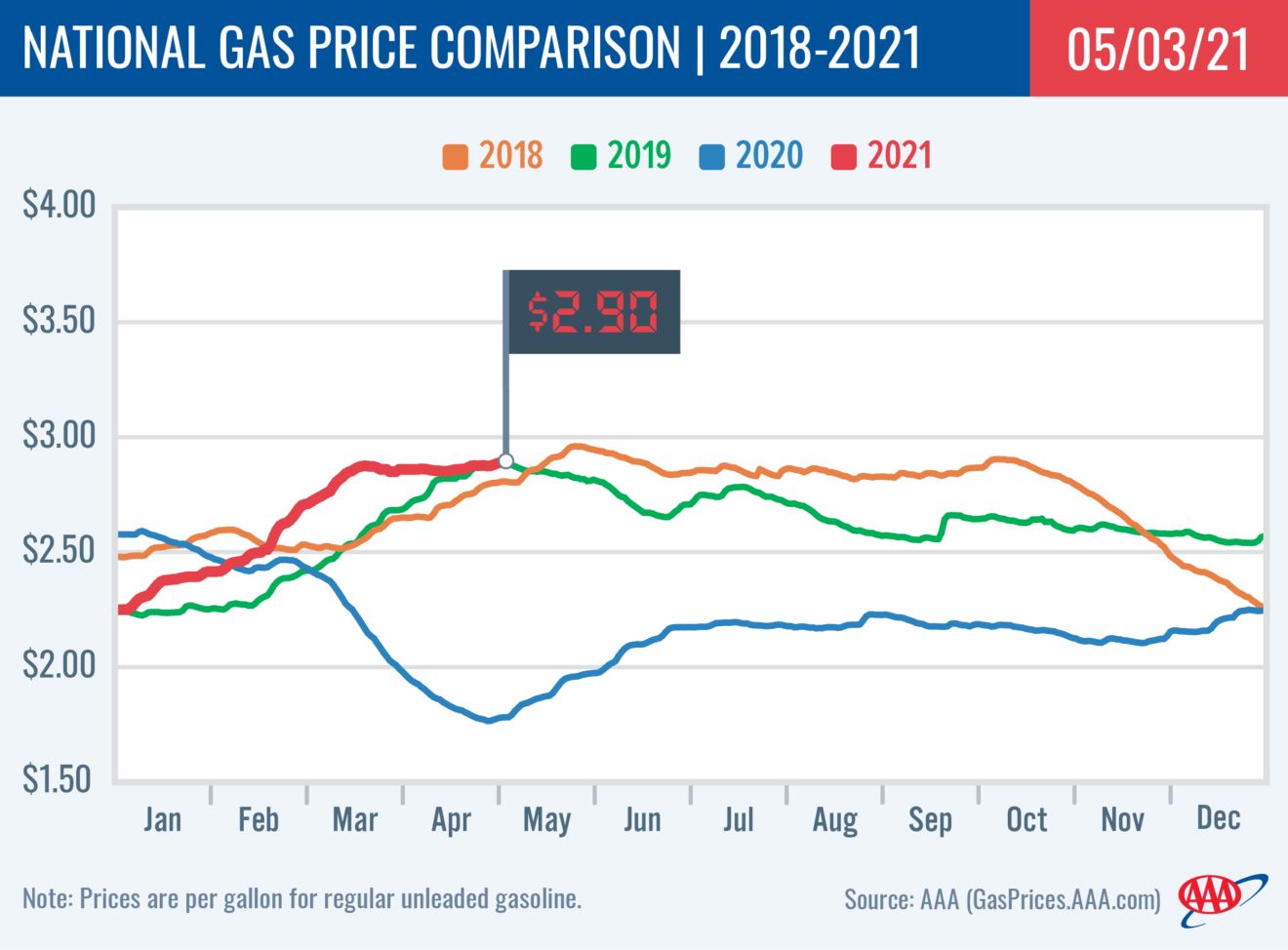
Gas prices have hovered around $2.80 on average. Image source: AAA
If the driver chose a Kona EV instead, they'd need to buy 28 kWh of electricity for every 100 miles they drive. At the average electricity price of $0.1751/kWh in California, they'd pay just $662. In a cheap electricity state like Florida ($0.1192/kWh), that annual energy cost drops to $450.
But charging that EV from solar is even better. Let us count the reasons:
- The levelized cost of solar energy is cheaper than grid power in most cases
- The cost of grid power goes up over time, while solar panels keep producing electricity without additional cost
- Solar panels are far less polluting than electricity from the grid:
- 450 gallons of gas results in 8,820 lbs of CO2 emissions
- 3,780 kWh of California grid power makes 1,531 lbs of CO2 (0.41 lbs/kWh + 35 lbs CO2 from EV lithium battery production)
- 3,780 kWh of home solar energy makes 368 lbs of CO2 (0.088 lbs/kWh + 35 lbs CO2 from EV battery)
Here's more about why EVs and solar panels are a perfect match:
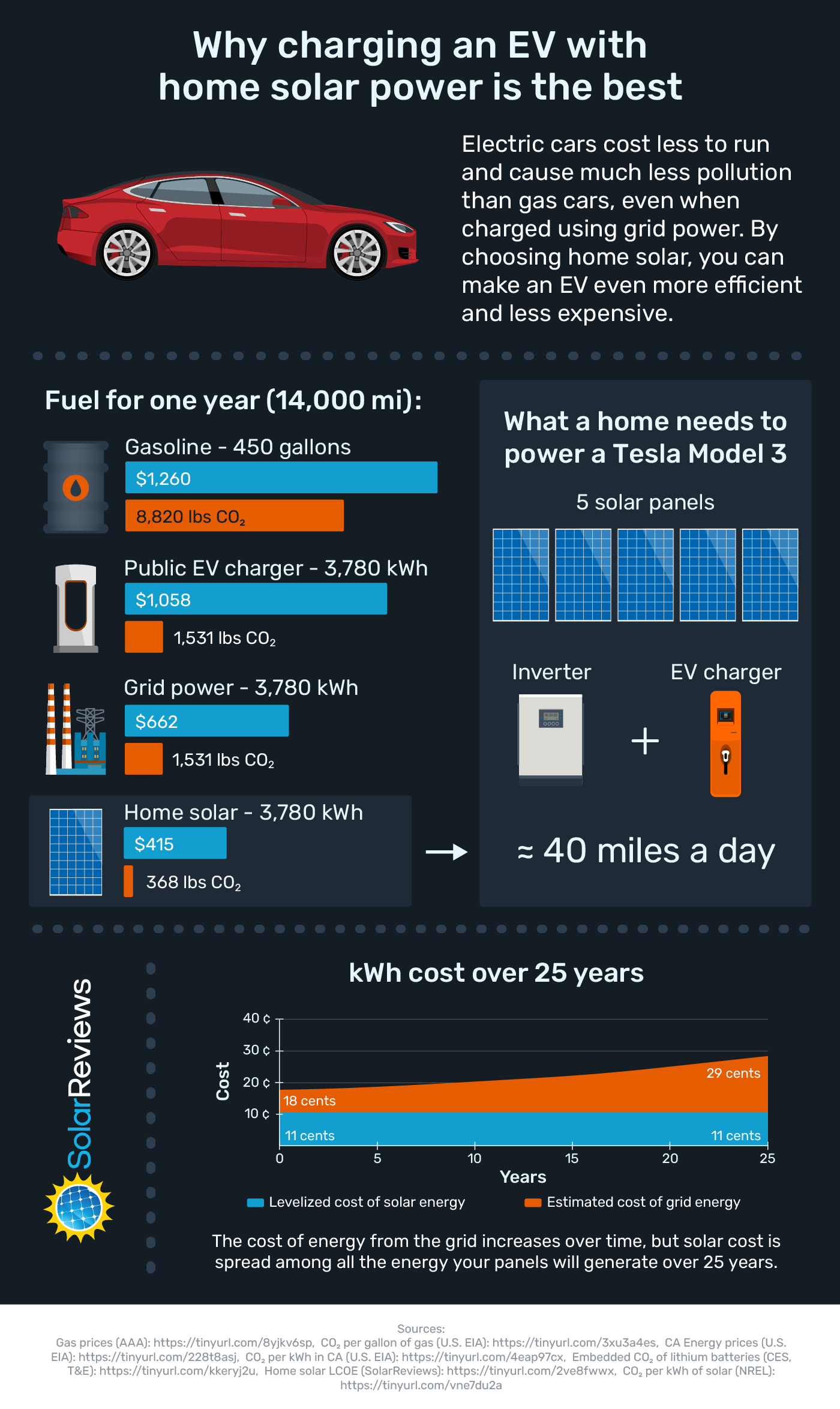
Why you should charge your electric car with solar panels
There are many specific advantages to pairing solar panels with your EV. Maybe the best one is that it's just cheaper. In nearly every state in the USA, the long-term cost of solar panels is less than buying electricity from the grid. In some cases, the cost of producing your own solar energy is more than 50% less than buying grid power.
You can install enough solar panels to meet your home's energy needs and charge your car, and save thousands of dollars over time. Plus, solar panels come with warranties to produce electricity for at least 25 years, so you'll be saving long into the future.
Another huge benefit of solar is the amount of waste it reduces. Switching to an EV already means you're cutting emissions by eliminating the need for gasoline and oil, but electricity from the grid still comes mostly from natural gas and coal.
Just a handful of solar panels on your roof is enough to provide energy to charge your first EV, and your second, your third, and so on. Again, those panels will last at least 25 years. No wonder they call it renewable energy. Who knows; maybe they'll even help power your first flying car?
How much does it cost to charge an electric car with solar and without?
When you own an electric vehicle, every outlet is potentially a way to get a few more miles into your car's batteries. Realistically, though, you'll want to find a level 2 EV charger for home use, or the equivalent of a Tesla supercharger if you're out on the road.
There are basically three ways to get the juice that'll keep your car on the road: the grid, public charging stations, or your own solar panels.
Here's how much each costs:
| Type of charging | Cost | Notes |
|---|---|---|
| Grid power at home | $.10 to $40 per kWh | Varies based on location and time; cheapest at night; cost increases over time |
| Public charging stations | $.28 to $.69 per kWh | Varies based on location and charging station owner; additional idle fees; some require monthly subscription; cost increases over time |
| Solar power at home | Less than $.11/kWh | Levelized over the course of the solar panels' lifetime; additional solar energy can be used to offset electricity bill |
Charging from the grid at home
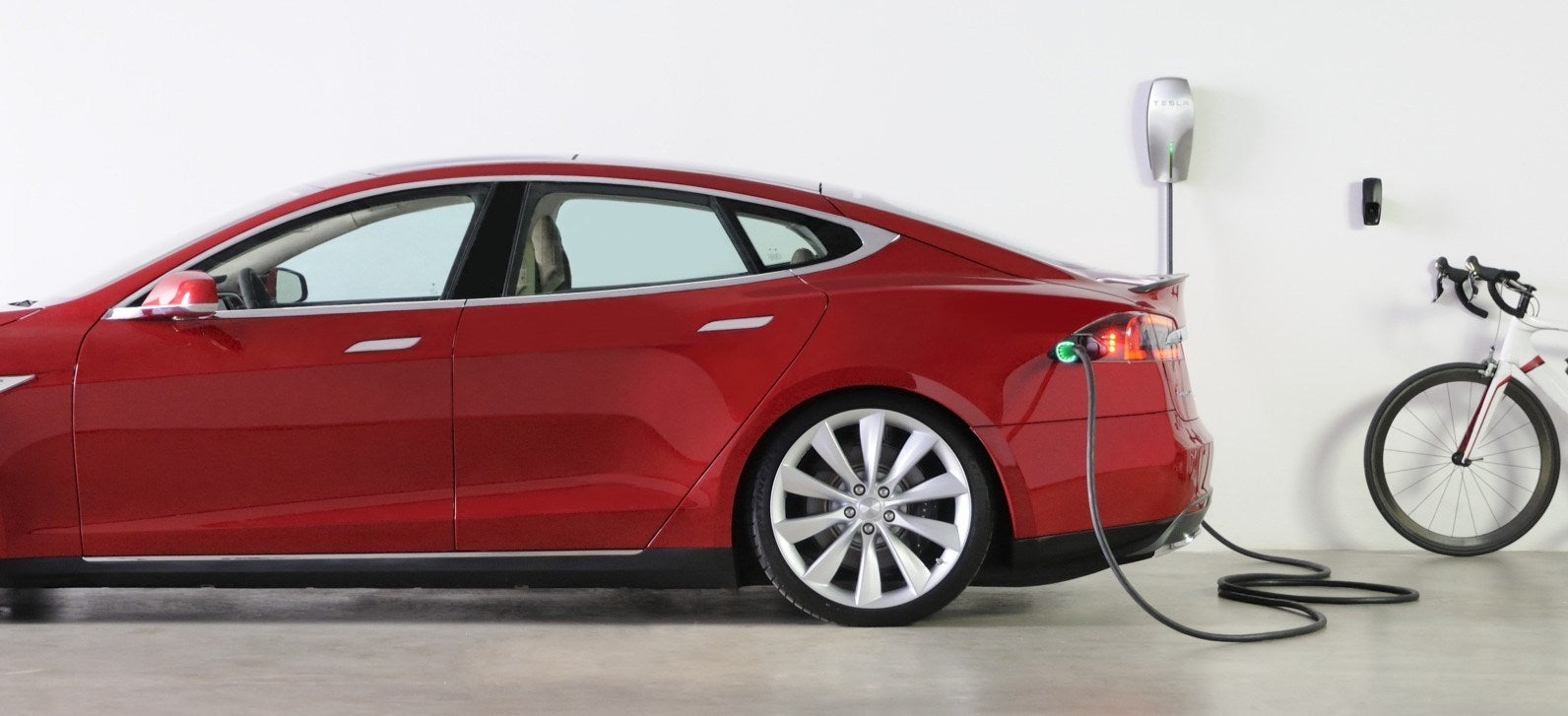
You can charge an EV at home without solar, but it'll cost you. Image source: Electrek
The ongoing cost of fuel from the grid is whatever you currently pay for a kilowatt-hour (kWh). In the United States, that can be between about $.10 and $.40 depending on where you live, but the average is about $.13/kWh. For every kWh in your battery, you'll get about 3-4 miles of range, so about 12 kWh will get you a 40-mile round trip every day, at an average cost of $1.56.
That's how it looks now, but electricity prices rise like everything else, so next year, you might be paying 2 or 3% more for electricity, and over the lifetime of your car, prices could rise much higher. Over the next 25 years, your average cost for a kWh of grid power will be around 17 cents if electricity prices rise 2% per year and you live in a state where electricity is currently $.13/kWh.
At historical rates of energy cost increase, Californians will start out paying $662 per year to charge an EV, and end up paying over $1,000 per year within 20 years when using grid power.
Complicating matters just a bit is the concept of Time-of-Use billing (TOU), which means that electricity costs different amounts at different times of day. As an EV owner, you likely have the option of choosing a TOU plan and charging your car exclusively at night, when electricity is cheapest. TOU billing rates vary widely between states, with some overnight off-peak rates as low as $.07/kWh, while others such as SDG&E in California bottom out at $.29/kWh.
Public charging stations
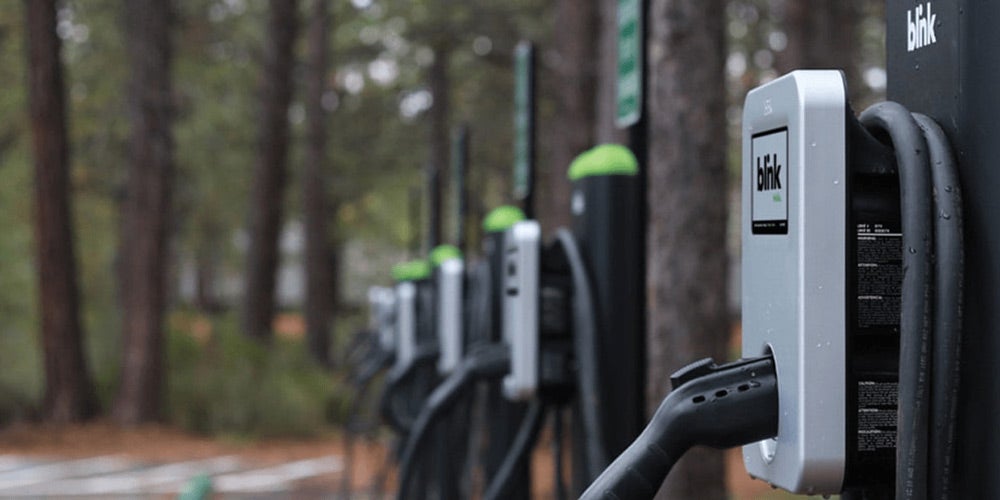
You won't need it often, but public EV charging stations are sometimes necessary. Image source: Electrive
When you're out in the world and need to top up the "tank," you're going to be looking for a public charging station to do it. To a certain extent, this is unavoidable if you own an EV, but you will save a lot of money if you can limit how often you do it.
Of course, there are free EV charging stations located all around the country, but for the most part, you'll probably be paying for the electricity you need, and paying a lot, at that.
Prices for charging vary by location. For example, Tesla charging stations currently cost $.28/kWh for Tesla owners. Services like Blink are even more costly, with a minimum charge of $.39/kWh, and a maximum of $.69/kWh for fast charging. Between Tesla and Blink, those charges are anywhere from 2 to 5 times more expensive than home charging from the grid.
Charging with home solar
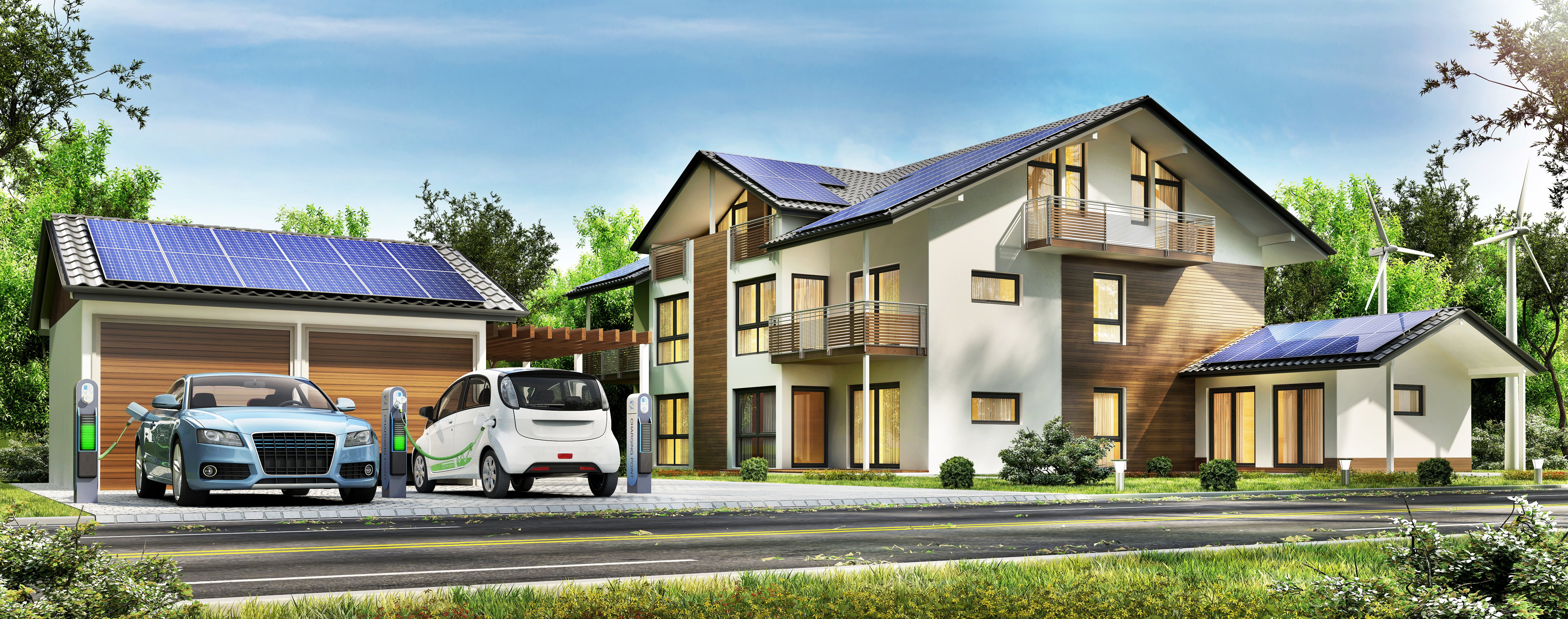
Realistically, you won't have wind turbines in your backyard, but you can dream!
If you pay for a solar panel system at your home, you'll have to either lay out some cash or take a solar loan and pay over time. That's not a small expense, but you can compare it to the cost of paying for electricity for the next 25 years.
To do that, you calculate something called the Levelized Cost of Energy, or LCOE, which is just the total cost of installation spread over all the electricity your solar panels will generate in their lifetimes and adjusted for inflation.
The good news here is the LCOE of home solar in the U.S. is currently about $.11/kWh for systems with a current average solar installation cost of $3.00 per watt (as of January 2022) before the federal solar tax credit. In states with lots of sun, like California, or states with additional incentives, like Massachusetts, solar LCOE is much lower.
Basically, by guaranteeing your fuel source (solar) for the next 25 years, you'll save a bundle of money on EV charging.
Do you need home solar batteries to store energy for EV charging?
Many people worry that they'll need a battery such as the Tesla Powerwall to store solar energy they will later use to charge their EV. We're here to tell you that's not necessary, and it may not even be very practical.
Take the Tesla Model 3: depending on which version you choose, it will have a battery of between 54 and 82 kWh. You would need between 4 and 6 Powerwalls in order to store enough energy to fill the car's battery from stored solar energy. Those Powerwalls would cost you at least $30,000, in addition to the cost of solar panels and a car.
Luckily, it's not necessary to drop 30 Gs on sleek home batteries. First, you won't often need to charge the full battery in one go. Second, you'll likely get net metering benefits, meaning you earn credit for extra solar energy that you send to the grid during the day, which you draw from when charging your car at night. With net metering, the grid acts as your "battery."
As an added bonus, net metering and TOU billing can combine to make solar car charging a heck of a good deal. When your solar panels make electricity during the day, you earn net metering credits at the higher daytime prices, and are then able to charge the car at the low overnight prices. It's the best of both worlds!
When solar charging isn't a good idea
The numbers we gave above are averages that show the general benefits of solar and EVs together. There will always be specific cases where charging an EV from solar isn't the best choice.
Specifically, if your state doesn't offer net metering, your utility has very low overnight energy prices on a TOU plan, or your roof isn't right for solar because it's too shaded, you might be better off charging your electric car from the grid.
Learn more: 7 reasons why you should hold off on solar panels
What about cars with solar panels built in?
I wish we had better news for you here, but cars with solar cells built into their bodies are not the answer to all the world's problems. In the best case, the solar cells will make enough electricity to get the car an extra 10 to 20 miles of range a day, in the most ideal sunny conditions.
How to charge an EV with solar
Now that you know why you should charge an electric car with solar panels, here's a little more about how to do it, to make sure you add the right number of panels and get a good value for the long term.
Here are the steps to use solar panels to charge your electric car:
- Step 1: Determine how many kWh you need for your car for your driving habits
- Step 2: Figure out how many solar panels you need to make those kWh
- Step 3: Purchase solar equipment that can make that much electricity
- Step 4: Get a Level 2 car charger
- Step 5: Enjoy!
1. Determine how many kWh you need every day
The first step is to find out how many kWh are needed to drive your car. If you keep track of mileage over a year, this step can be pretty easy. If not, you can estimate using an average number of miles per day.
According to the U.S. Department of Transportation, the average American drives about 13,500 miles per year, or about 40 miles per day. Let's use that as a baseline. Here are the most efficient electric cars for 2022, excluding plug-in hybrid cars:
Top 15 U.S. electric vehicle models in 2022 by efficiency
| Make and Model | kWh for 40 mi. daily range* |
|---|---|
| Tesla Model 3 Standard Range Plus | 9.6 |
| Hyundai Ioniq | 10 |
| Tesla Model Y Standard Range | 10.4 |
| Hyundai Kona | 11.2 |
| Chevy Bolt | 11.6 |
| BMW i3 | 12 |
| Kia Niro | 12 |
| Nissan Leaf (40 kWh battery pack) | 12 |
| Tesla Model S Performance (19-inch wheels) | 12.4 |
| Mini Cooper SE Hardtop | 12.4 |
| Tesla Model X Long Range Plus | 12.8 |
| Ford Mustang Mach-E | 13.6 |
| Volkswagen ID.4 | 14 |
| Polestar 2 | 14.8 |
| Porsche Taycan 4S | 16.8 |
*Sorted by kWh per 40 miles; data from FuelEconomy.gov; where multiple trim levels exist, the most efficient was chosen to limit each car model to one entry.
2. How many solar panels you need to charge your electric car
Based on the table above, you'll need between around 10 and 17 kWh of electricity per day to charge an electric car. Now it's time to figure out how many solar panels you'll need to make that much electricity.
The average modern solar panel can put out around 350 watts under full sun, and gets between 3 and 7 peak sun hours per day, depending on where you live. That means our solar panel makes between 1.05 to 2.45 kWh of electricity every day (350 x 3 at the low end or 350 x 7.5 at the high end).
Let's say you get 1.75 kWh per day, per panel. You'd need just over five panels to make enough energy to charge a Tesla Model 3 battery and get 40 miles of range. That's not very many! Of course, the number of panels increases if you need more than a 40-mile range.
Using the same math, you can determine that you'll need about seven 350-watt panels to charge a Nissan Leaf. On the high side, you'd need 10 panels to make enough energy to drive 40 miles in a Porsche Taycan 4S. Clearly, that is a car that doesn't sip the sun juice.
3. Buy the equipment needed to charge your electric car with solar
Of course you can't just stick five solar panels on your roof and plug them into your car. You need a solar panel system and all the equipment that goes with it.
A typical solar EV charging setup would include the following:
- Solar panels on your roof, mounted on metal racks and attached to the roof deck
- Either a central string inverter that combines the DC output of the solar panels to AC, or micro-inverters that convert each panel's output to AC and send it to a combiner box that connects to your main AC panel
- A Level 2 EV charger (or, combine 2 into 1 with an EV-charging solar inverter like the SolarEdge SE3800H)
4. Charge your EV
If you already have a solar array installed and you're thinking about adding an EV, you can probably just get a Level 2 EV charger if you have a free 20 to 80-amp breaker in your main panel.
If you currently have enough solar panels installed to meet your needs and you want to offset the extra energy that will be used to charge your EV, you can use the guide above to see how many panels you'll need for your estimated usage. You can also use our free and easy-to-use solar panel calculator.
5. Enjoy
Congratulations! You now have a solar-powered electric car. To be fair, unless you're charging during the day when the sun is up, the electrons stored in your car's batteries won't be the same ones knocked loose from the silicon in your panels.
Instead you'll be producing enough solar electricity to offset your car's needs over the course of the year, reducing your carbon footprint, and saving money - all at the same time. And those same five panels will produce enough electricity for your next car, and the one after that, too. 25 years of fuel, all on a small section of your roof!
The bottom line:
Making the switch from fossil fuels to solar electricity is good for your pocketbook, and also a great way to reduce your carbon footprint. The higher initial cost of an electric car can be quickly offset by the fuel cost savings you'll see, and many EVs still qualify for state and federal tax credits to reduce the upfront cost by $7,500 or more.
The amount of energy you'll need depends on your car's battery capacity and your average miles driven per day, but no matter how much electricity you need, you'll probably save a lot of money if you charge that car with home solar panels.
Key takeaways
- Electric cars are more efficient and less expensive than gas cars.
- Home solar is cheaper and less polluting than grid power over the long term in almost every place in the United States.
- Public EV charging is even more expensive than grid power and no less polluting, for the most part.
- Charging an EV from home solar panels is better for the environment and your pocketbook in almost all cases.
- A home needs between 5 and 10 solar panels to charge an EV for 40 or more miles per one day of driving.
Source: https://www.solarreviews.com/blog/how-much-solar-do-i-need-to-charge-my-electric-car
0 Response to "Solar Panel Due to Continuous Recharging One Full Charge Can Run for 3 Days"
Post a Comment